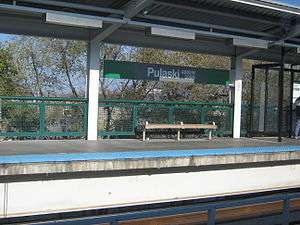Pulaski (CTA Green Line station)
| ||||||||||||||||||||||||||||||||||||||||||||||||||||||||||||||||||||||||||||
|---|---|---|---|---|---|---|---|---|---|---|---|---|---|---|---|---|---|---|---|---|---|---|---|---|---|---|---|---|---|---|---|---|---|---|---|---|---|---|---|---|---|---|---|---|---|---|---|---|---|---|---|---|---|---|---|---|---|---|---|---|---|---|---|---|---|---|---|---|---|---|---|---|---|---|---|---|
 | ||||||||||||||||||||||||||||||||||||||||||||||||||||||||||||||||||||||||||||
| Location |
4000 West Lake Street Chicago, Illinois 60624 | |||||||||||||||||||||||||||||||||||||||||||||||||||||||||||||||||||||||||||
| Coordinates | 41°53′07″N 87°43′31″W / 41.885412°N 87.725404°W | |||||||||||||||||||||||||||||||||||||||||||||||||||||||||||||||||||||||||||
| Owned by | Chicago Transit Authority | |||||||||||||||||||||||||||||||||||||||||||||||||||||||||||||||||||||||||||
| Line(s) | ||||||||||||||||||||||||||||||||||||||||||||||||||||||||||||||||||||||||||||
| Platforms | 2 Side platforms | |||||||||||||||||||||||||||||||||||||||||||||||||||||||||||||||||||||||||||
| Tracks | 2 tracks | |||||||||||||||||||||||||||||||||||||||||||||||||||||||||||||||||||||||||||
| Construction | ||||||||||||||||||||||||||||||||||||||||||||||||||||||||||||||||||||||||||||
| Structure type | Elevated | |||||||||||||||||||||||||||||||||||||||||||||||||||||||||||||||||||||||||||
| Bicycle facilities | Yes | |||||||||||||||||||||||||||||||||||||||||||||||||||||||||||||||||||||||||||
| Disabled access | Yes | |||||||||||||||||||||||||||||||||||||||||||||||||||||||||||||||||||||||||||
| History | ||||||||||||||||||||||||||||||||||||||||||||||||||||||||||||||||||||||||||||
| Opened | March 1894 | |||||||||||||||||||||||||||||||||||||||||||||||||||||||||||||||||||||||||||
| Rebuilt | 1973, 1996, 2001 | |||||||||||||||||||||||||||||||||||||||||||||||||||||||||||||||||||||||||||
| Previous names | 40th Avenue, Crawford Avenue | |||||||||||||||||||||||||||||||||||||||||||||||||||||||||||||||||||||||||||
| Traffic | ||||||||||||||||||||||||||||||||||||||||||||||||||||||||||||||||||||||||||||
| Passengers (2015) |
566,019[1] | |||||||||||||||||||||||||||||||||||||||||||||||||||||||||||||||||||||||||||
| Rank | 102 out of 143[lower-alpha 1] | |||||||||||||||||||||||||||||||||||||||||||||||||||||||||||||||||||||||||||
| Services | ||||||||||||||||||||||||||||||||||||||||||||||||||||||||||||||||||||||||||||
| ||||||||||||||||||||||||||||||||||||||||||||||||||||||||||||||||||||||||||||
| ||||||||||||||||||||||||||||||||||||||||||||||||||||||||||||||||||||||||||||
Pulaski is an elevated, side platformed rapid transit station on the Chicago Transit Authority's 'L' system, serving the Green Line. Pulaski is located at the intersection of Lake Street and Pulaski Road in the West Garfield Park neighborhood of Chicago, Illinois. The station opened in March 1894.
History
Pulaski was constructed in 1892-94 and opened in March 1894 as part of the Lake Street Elevated Railroad. The station was constructed in the Queen Anne architectural style, as were the other Lake Street stations. In 1956, Pulaski's platforms were lengthened by 200 feet from the east end and additional entrances to the station were opened at Harding Avenue after the closing of the nearby Hamlin station. The Harding Avenue entrance to the eastbound platform became exit-only in 1960, but the westbound entrance remained open. Pulaski was rebuilt in 1973, and the original station houses were demolished at this time. On December 18, 1993, the westbound Harding Avenue exit was closed. In 1994 Pulaski closed along with the rest of the Green Line so it could be rebuilt. The platforms at the station were completely rebuilt during its closure, but the original fare controls were kept, so the old platforms were converted into walkways between the fare controls and the platform. A wooden railing was erected on the old platforms to keep passengers away from the tracks. This arrangement was designed to be temporary in the hopes that Pulaski could be turned into a "super-station", but by 1999 the CTA gave up on the super-station plan and built a new station house which connected to the new platforms. The old platforms and fare controls were removed in 2011.[2]
Services
As part of the Green Line, Pulaski is used by those traveling between the West Garfield Park neighborhood and other areas served by the line, including Oak Park and Forest Park, the Loop, and the South Side. Trains to Harlem/Lake arrive approximately every ten minutes; trains toward Ashland/63rd and Cottage Grove arrive every ten minutes as well, and alternating trains go to each terminus.
Pulaski has separate station houses and fare controls for the inbound and outbound platforms. Farecard vending machines are present at both entrances. A customer assistant booth is located at the inbound entrance; passengers at the outbound entrance must press a call button if they need assistance. The station's elevated platforms are accessible via stairs and elevators; both platforms are wheelchair accessible. An overhead footbridge connects the two platforms, but it may only be used by CTA employees. Pulaski is connected to the Bethel New Life community center next to the station via a bridge from the outbound station house.
Bus connections
- 53 Pulaski (Owl Service)
Notes and references
Notes
- ↑ Due to possible double-counting of physically-connected stations, the CTA's official 2015 tally of stations was 146, but for ridership purposes reported having only 143 stations.
References
- ↑ "Monthly Ridership Report – December 2015" (PDF). Chicago Transit Authority Ridership Analysis and Reporting. January 11, 2016. Retrieved March 12, 2016.
- ↑ "Pulaski Renewal Progress". Retrieved 24 November 2012.
External links
| Wikimedia Commons has media related to Pulaski (CTA Green Line). |
- Pulaski (Lake Street Line) Station Page
- Karlov Avenue entrance from Google Maps Street View
- Pulaski Road entrance from Google Maps Street View